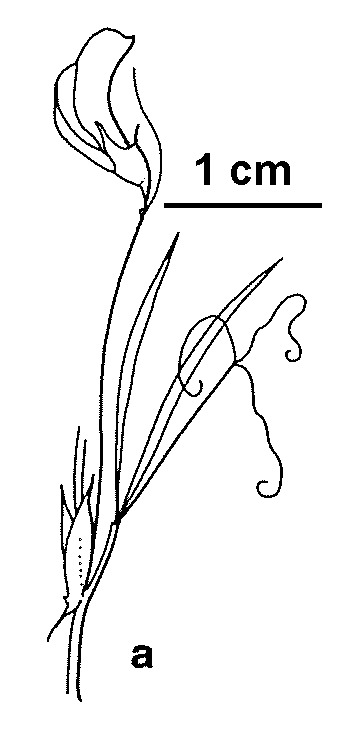Lathyrus angulatus
L. Angular PeaProstrate or climbing annual herb; stems 10–60 cm long, glabrous, angular, not winged. Leaflets linear to linear-ovate, 1–6 cm long, 1–7 mm wide, glabrous, apices acuminate; tendrils usually 1–3; petiole 5–8 mm long; stipules linear, semi-sagittate, 7–14 mm long. Flowers solitary, rarely 2; pedicel 0.5–2 mm long; peduncle 2–7 cm long, with an apical tendril-like appendage to c. 15 mm long; bract c. 0.5 mm long, lobed; calyx c. 5 mm long, glabrous, teeth all more or less equal to tube; corolla 8–10 mm long, pale blue to purple; standard obovate-obcordate, c. 7 mm wide, distinctly veined; wings long-clawed, auricle small; keel long-clawed, acuminate; style not twisted. Pod linear, 2–5 cm long, 3–5 mm wide, glabrous; seeds 6–15, c. 2.5 mm long, wrinkled to tuberculate, dark brown. Flowers Sep.–Nov.
VVP, MuF, GipP, Gold, CVU. Also naturalised Qld, NSW, ACT. Native to Europe, Mediterranean region. Apparently naturalised in the Castlemaine and Cobram areas of northern Victoria.
Often confused with L. sphaericus Retz. (Slender Wild-pea) which has smooth seeds and shorter peduncles (5–10 mm) not greatly exceeding the bract.
Jeanes, J.A. (1996). Fabaceae. In: Walsh, N.G.; Entwisle, T.J., Flora of Victoria Vol. 3, Dicotyledons Winteraceae to Myrtaceae, pp. 663–829. Inkata Press, Melbourne.
 Spinning
Spinning
